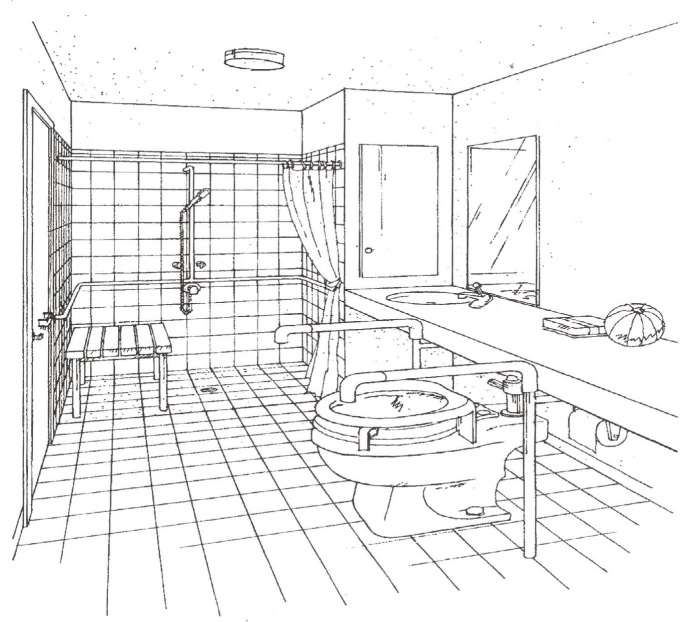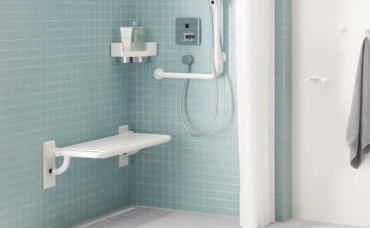the shower area doubling as wheelchair maneuvering space, for access to bathroom amenities (WC, Sink etc). At this stage, it may be worthwhile to consider making provisions for grab-bars for current and future needs. It is recommended to select the shower seat that is height adjustable, can be moved along the grab bar rail if needed, and folded up or removed, depending on the user.
Water-Closet/WC: Installation of a wall-hung WC w/flush controls on the wall adds more space in the bathroom, while freeing up the floor space to facilitate maintenance and cleaning. It is advisable to make solid attachment provisions in the wall for the grab-bars. The grab-bars can be pivoting (up/down arms) so they can be moved out of the way when not needed. An advantage of the wall hung WC is that it can be installed at an optimal height for transfer from the wheelchair.
Vanity Sink: Adjustable height sinks are available in the marketplace. Eliminate the under sink cabinet to facilitate access to the sink bowl and faucets. If space permits, plan for a full height utility cabinet, forming one of the walls of the shower.
Floor Heating: Consider low voltage radiant heating in the bathroom floor, topped by ceramic tiles. This option allows keeping the floor dry and warm.

TYPICAL EXAMPLE OF AN ACCESSIBLE BATHROOM
- Space for wheelchair either side of WC.
- WC with recessed base
- Adjustable height WC seat or seat extender
- Swing away grab bars
- 20" - 28" depth counter
- Washbasin within reach of the seated position on WC
- Mixing faucet, level handle within reach of the seated position on the WC
- Mirror, lower edge no higher than 40"
- 27" high knee space under counter, drainpipe covered or insulated
- Medicine chest within reach
- Space for transfer to a shower seat
- Free-standing shower seat, placement either end of shower or removed
- No curb for shower stall, the chairbound can wheel directly into the shower, shower stall to slopes to center drain IMAGES PROVIDED BY RAMESH GULATEE CLEAN DESIGN: Universal design bathrooms feature curbless shower stalls and shower seats for the chairbound.
- Grab bars, 3 sides of shower stall
- Controls centered on back wall of shower stall
- Hand shower
- Out swinging bathroom door with lever handle
- Door pull, hinge side of door
5. KITCHEN: FOOD PREPARATION AND DINING
In addition to the bathroom, the kitchen is another space that requires careful accessibility planning consideration, due to frequent and repeated access to appliances.
Countertop: In most homes the kitchen countertop is installed at a height (+34") to match the kitchen sink and the cooktop. A fixed height and under counter cabinets create reach/access issues for individuals with mobility impairments, elderly and children.
Accessibility Options: Install a height adjustable countertop located adjacent or between the sink and the cooktop. Consider including double stacked wall-ovens in kitchen planning (This creates options for the cooktop as part of an island-style countertop or as part of height adjustable countertop)
Kitchen Cabinets: (below countertop) Generally, the kitchen cabinets form part of an integral support system with the countertop. This creates knee space issues and precludes height adjustability for the kitchen countertop.
Accessibility Options: Consider independently framed and supported countertops with provision for height adjustment where needed. Consider individual under counter cabinets on casters (approx. 24" wide units) that can be pulled out from under the countertop and pushed back, when not in use.


CLEAN DESIGN: Universal design bathrooms feature curbless shower stalls and shower seats for the chairbound.